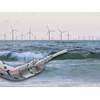Bubbling Methane Vents Discovered Off US E. Coast
Mississippi State University (MSU) researchers say they have found more than 500 bubbling methane vents on the seafloor off the US east coast.
Lead author Adam Skarke, assistant professor of geosciences at Mississippi State University (MSU) worked with researchers from the U.S. Geological Survey (USGS) and other institutions on a scientific team that discovered methane seeps in unlikely places along the seafloor on the northern part of the U.S. Atlantic margin.
Before he joined the faculty at MSU, Skarke worked as a physical scientist at the National Oceanic and Atmospheric Administration's (NOAA) Office of Ocean Exploration and Research (OER). As part of a large team of scientists and technicians, Skarke participated in many cruises on the NOAA ship Okeanos Explorer as it mapped the Atlantic Ocean floor between North Carolina and Cape Cod. The discovery of gas plumes in the water column over the seafloor, detailed in the new publication, used data the ship collected starting in 2011, Skarke explains.
Methane often naturally leaks from the seafloor, particularly in petroleum basins like the Gulf of Mexico or on tectonically active continental margins like the U.S. Pacific Coast, Skarke said. However, the geologic characteristics of the U.S. Atlantic margin suggest the seepage was not necessarily expected there because the tectonically passive area lacks an underlying petroleum basin.
The team thinks that many of the newly-discovered seeps may be related to the breakdown of a special kind of "methane ice" or gas hydrate, a frozen combination of methane and water stable in sediments below 500 or more meters, or 1,640 feet, of ocean water, Skarke said. With small changes in ocean temperature, gas hydrate can release its methane into the sediments, and the gas may escape at the seafloor to form plumes in the water column.
"Globally, the upper ocean has been warming for decades," Skarke said. "Some of the seeps we found are similar to those on Arctic Ocean margins, where warming has been more rapid. But we also know that some subsets of the seeps have probably been active for over 1,000 years. A key question is how the long-term seepage and short-term warming of the ocean are related to methane escape."
Skarke said the research "does not provide sufficient evidence to draw objective conclusions about the relationship between these methane seeps and global climate change."
The group's scientific paper, "Widespread methane leakage from the sea floor on the northern U.S. Atlantic margin," was published online Sunday [Aug. 24, 2014] by the peer-reviewed journal 'Nature Geoscience'.
To view the complete abstract of "Widespread methane leakage from the sea floor on the northern U.S. Atlantic margin" visit: dx.doi.org/10.1038/ngeo2232
















 February 2024
February 2024



